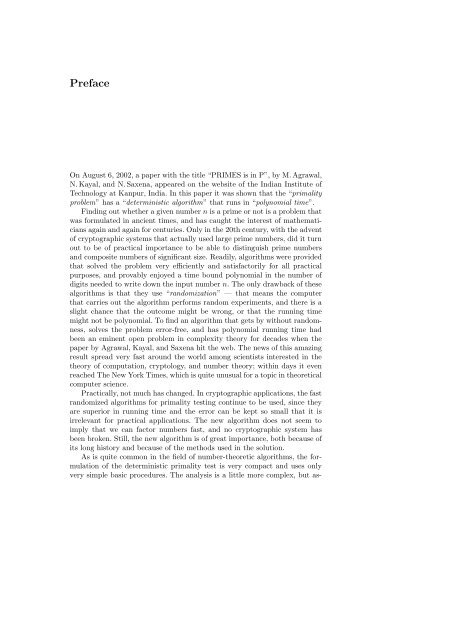Dietzfelbinger M. Primality testing in polynomial time ... - tiera.ru
Dietzfelbinger M. Primality testing in polynomial time ... - tiera.ru
Dietzfelbinger M. Primality testing in polynomial time ... - tiera.ru
Create successful ePaper yourself
Turn your PDF publications into a flip-book with our unique Google optimized e-Paper software.
Preface<br />
On August 6, 2002, a paper with the title “PRIMES is <strong>in</strong> P”, by M. Agrawal,<br />
N. Kayal, and N. Saxena, appeared on the website of the Indian Institute of<br />
Technology at Kanpur, India. In this paper it was shown that the “primality<br />
problem” hasa“determ<strong>in</strong>istic algorithm” that <strong>ru</strong>ns <strong>in</strong> “<strong>polynomial</strong> <strong>time</strong>”.<br />
F<strong>in</strong>d<strong>in</strong>g out whether a given number n is a prime or not is a problem that<br />
was formulated <strong>in</strong> ancient <strong>time</strong>s, and has caught the <strong>in</strong>terest of mathematicians<br />
aga<strong>in</strong> and aga<strong>in</strong> for centuries. Only <strong>in</strong> the 20th century, with the advent<br />
of cryptographic systems that actually used large prime numbers, did it turn<br />
out to be of practical importance to be able to dist<strong>in</strong>guish prime numbers<br />
and composite numbers of significant size. Readily, algorithms were provided<br />
that solved the problem very efficiently and satisfactorily for all practical<br />
purposes, and provably enjoyed a <strong>time</strong> bound <strong>polynomial</strong> <strong>in</strong> the number of<br />
digits needed to write down the <strong>in</strong>put number n. The only drawback of these<br />
algorithms is that they use “randomization” — that means the computer<br />
that carries out the algorithm performs random experiments, and there is a<br />
slight chance that the outcome might be wrong, or that the <strong>ru</strong>nn<strong>in</strong>g <strong>time</strong><br />
might not be <strong>polynomial</strong>. To f<strong>in</strong>d an algorithm that gets by without randomness,<br />
solves the problem error-free, and has <strong>polynomial</strong> <strong>ru</strong>nn<strong>in</strong>g <strong>time</strong> had<br />
been an em<strong>in</strong>ent open problem <strong>in</strong> complexity theory for decades when the<br />
paper by Agrawal, Kayal, and Saxena hit the web. The news of this amaz<strong>in</strong>g<br />
result spread very fast around the world among scientists <strong>in</strong>terested <strong>in</strong> the<br />
theory of computation, cryptology, and number theory; with<strong>in</strong> days it even<br />
reached The New York Times, which is quite unusual for a topic <strong>in</strong> theoretical<br />
computer science.<br />
Practically, not much has changed. In cryptographic applications, the fast<br />
randomized algorithms for primality <strong>test<strong>in</strong>g</strong> cont<strong>in</strong>ue to be used, s<strong>in</strong>ce they<br />
are superior <strong>in</strong> <strong>ru</strong>nn<strong>in</strong>g <strong>time</strong> and the error can be kept so small that it is<br />
irrelevant for practical applications. The new algorithm does not seem to<br />
imply that we can factor numbers fast, and no cryptographic system has<br />
been broken. Still, the new algorithm is of great importance, both because of<br />
its long history and because of the methods used <strong>in</strong> the solution.<br />
As is quite common <strong>in</strong> the field of number-theoretic algorithms, the formulation<br />
of the determ<strong>in</strong>istic primality test is very compact and uses only<br />
very simple basic procedures. The analysis is a little more complex, but as-












